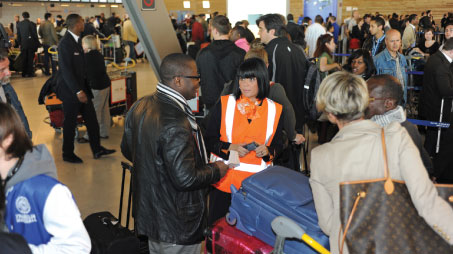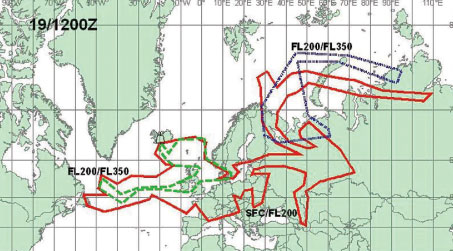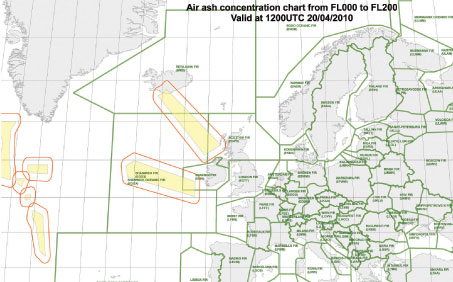
During the height of the volcanic ash crisis between 14 and 21 April, much of the focus on resolving the situation was centred around Brussels. European mobility had broken down, air space by air space, as an untested methodology for analysing the threat of volcanic ash had been replicated by civil aviation authorities across the continent.

Aéroports de Paris distributed blankets, bottles of water and baby kits to passengers stranded in its terminals and ensured bars and restaurants remained open throughout the night. It also reinforced its customer care staff on site, in order to be able to inform and assist passengers.
At its worst moment, the threat of volcanic ash paralysed 313 airports – about 80% of the European airport network. Most of Europe’s airlines didn’t have a single aircraft in the sky at that point – for the first time in over 65 years. More than 10 million passengers affected all had one thing in common – they couldn’t get to where they needed to go.
Representatives of ACI EUROPE spent most of that weekend in EUROCONTROL, in high-level negotiations with the European Commission’s Transport Directorate (DG MOVE), EUROCONTROL, the Spanish Presidency of the EU and the Association of European Airlines (AEA).
EUROCONTROL has several roles, all of which are intended to develop safety and efficiency in Air Traffic Management across Europe. In the context of the volcanic ash cloud, its role in flow management was particularly important. EUROCONTROL’s Network Operations Portal, which provides operational updates to technical stakeholders, was receiving over 200 ‘hits’ every second on Friday 16 April. “When the ash cloud was at its peak, in addition to managing what flows were taking place, we were working together with colleagues throughout the industry to bring together the experts – in fields such as volcanology, meteorology, jet engines and aviation, to share the results of modelling, ground-based observations and test flights and to come up with a way of improving how we were collectively managing the crisis,” explained David McMillan, Director General, EUROCONTROL. “Based on all this information, EUROCONTROL, in close cooperation with the European Commission, hosted a teleconference on 19 April with experts, Member States, air navigation service providers and industry representatives. A proposal for a revised approach was agreed and then made to the European Union Transport Ministers who adopted it. Within hours, the revised approach was being implemented and aircraft were able to fly in previously restricted areas.”
In terms of traffic, European airports lost around 18 million passengers during the six-day period and sporadic air closures ever since, resulting in over €290 million in lost revenues and additional extra assistance provided to stranded passengers.
In the immediate aftermath of the volcanic ash crisis, ACI EUROPE called for a European Aviation Relief Plan from the European Commission and submitted a joint paper with the AEA, detailing the extraordinary blow that the incident dealt to the air transport industry.
A few days later, on 27 April, European Commission Vice-President for Transport Siim Kallas gave a press conference on the impact of the volcanic ash crisis, during which he said “Sometimes we don’t really appreciate the value of something, until we don’t have it anymore – that is what happened with aviation last week.” Kallas also highlighted key areas where relief could be provided at European and national levels and clearly stated that the Commission’s estimate of €2.5 billion in losses, included airlines, airports, tour operators and ground handlers. This indicated that the exceptional circumstances “may justify support measures to offset losses incurred”. Olivier Jankovec, Director General, ACI EUROPE, said “The European Commission has come forward with proposals that could constitute a feasible European Aviation Relief Plan. We are pleased to see that their assessment takes into account the impact on the entire air transport industry, including airports and their commercial partners. It is clear from the losses sustained by Europe’s airports that they must be part of any compensation measures.”
The plan also refers to the need for pan-European enforcement of EU Passenger Rights legislation and to urgently address risk management planning for any future disruption caused by volcanic activity, while structural issues include the need to address pan-European crisis planning for transport for any future major disruption. The European Commission will also establish an Aviation Platform to bring together all aviation stakeholders at European level to ensure better coordination of measures impacting on the aviation sector over the long-term.
The six-day closure of European airspace aptly illustrated the urgent need for a fully functioning Single European Sky – a fact recognised by Kallas, who commented on the need to fast-track the Single Sky Package. “We need a Single European Regulator for a Single European Sky. Stronger European coordination will not solve every problem. But faced with such a pan-European crisis, it would have enabled a much more agile response. The European Commission stands ready to fast-track its work to have many core elements of the Single Sky II Package in place by the end of this year,” he said.
ACI EUROPE has repeatedly commended the leadership of European Commission Vice-President for Transport Siim Kallas and EUROCONTROL in securing a European response that effectively allowed the reassessment of the initial restrictions imposed at national level.
European Commission Aviation Relief Plan
The European Commission’s Aviation Relief Plan was announced on 27 April 2010. It includes:
- Possibility for Member States to financially compensate the air transport industry (including airlines, airports and our business partners) for the losses and additional costs resulting from the closure of the airspace (the EC would consider that no State aid is involved. It is ready to prepare a more detailed Communication on this issue to set out a common framework/conditions and guide Member States in their action).
- Operational flexibility at airports (possibility to waive or relax operating restrictions during the transition period required to ensure the return to normality).
- Development of a European methodology and coherent approach for safety risk assessment and risk management in relation to the closure and reopening of airspace (including the alternative procedure which allowed to re-open the airspace in this case).
- Acceleration of the implementation of the Single European Sky (SES2), in particular as regards the establishment of the Network Manager, appointment of a FABs coordinator and implementation of the performance regulatory framework (+ also creation of a Crisis Coordination cell with EUROCONTROL, EASA and the industry).
- Acceleration of aviation negotiation/liberalisation with all EU neighbouring countries to accelerate traffic recovery/development (ALL countries to the East of the EU and to the South of the Mediterranean).
In addition to these measures, which we specially asked for, the position of the EC also includes:
- Establishment of a European Mobility Action Plan for future disruptions in the transport sector, so as to allow quick deployment of capabilities in unaffected/alternative modes.
- Establishment of an EC AVIATION PLATFORM (with industry participation) to follow-up the recommended relief measures and improve long-term EU coordination for aviation.
New ‘grey’ zone introduced
Since then, work has been ongoing to further refine the methodology and procedures in place to deal with the volcanic ash threat. As a result, on 21 May, the European Aviation Safety Agency (EASA) introduced a Safety Information Bulletin based on airspace zones defined by EUROCONTROL, with the aim of minimising airspace closures in the event of further volcanic ash. Patrick Goudou, EASA executive director, said: “EASA’s mission is aviation safety. Together with EUROCONTROL and the European Commission, we have found a European approach which offers both safety and flexibility. This is good news for operators.”

The threat of ash-contaminated airspace was calculated based on perceived risk of ash cloud movement, rather than genuine presence of ash, which led to the definition of a much wider zone of contamination.
The airspace zones are named after the colour used to indicate them on charts produced by the Volcanic Ash Advisory Centre in London: A white zone where normal flight operations apply; a red zone in which some volcanic ash may be encountered, but in which EASA considers that flights can take place; a grey zone in which EASA recommends two approaches that allow flights under certain conditions; and a black zone in which EASA recommends banning flights because predicted ash concentrations exceed acceptable engine manufacturer tolerance levels.
The evolution here lies in the creation of the grey zone, which will afford Member States greater flexibility in managing their airspace. Previously, the air space covered by the grey zone was off-limits. “The strategies that can be employed to minimise disruption include the approach adopted on 21 May which includes the addition of a grey zone in which flight may be permitted under certain circumstances. This is combined with longer-term forecasts and ash plume models that are refined on the basis of a significantly increased number of actual measurements,” explained McMillan. “How best to coordinate the response is also being reviewed and the European Commission and EUROCONTROL are working together to set up a crisis management cell that would be able to deal more speedily with this and other major disruptions to air traffic.” On 3 June 2010, ACI EUROPE participated in the first meeting of this newly established crisis management cell.
Jankovec described EASA’s involvement as a step in the right direction, but further progress is needed to deliver a fully harmonised and calibrated European procedure. “Until we get there, further random closures of airspace cannot be excluded. The resulting uncertainty continues to impact consumer demand.”
Airports rally to aid of stranded passengers

Europe’s airports ensured the safety and comfort of passengers, with many, such as Munich (pictured) providing beds, blankets, bottles of water and medical support, while a few also provided free internet access and even entertainment.
Europe’s airports – big and small – were proactive in responding to the needs of passengers affected by the closure of airspace. As a first wave response, they launched information campaigns, in collaboration with air carriers, air navigation service providers and national authorities, to ensure that passengers were kept informed of the status of their flights. They also ensured the safety and comfort of passengers, with many airports providing beds, blankets, bottles of water and medical support, while a few also provided free internet access and even entertainment, as in the case of Amsterdam Schiphol. The disruption cost the Dutch airport around €17 million. With transit passengers caught in the middle of the situation and unable to leave the terminal due to Customs restrictions, Schiphol put in place a comprehensive strategy to aid the 2,000 passengers stranded in its lounges, with beds, meals, cinema, free internet and magazines, use of a terrace for fresh air, showers and clean clothes.
The six-day shutdown of UK-controlled airspace saw an unprecedented 20% reduction in the number of flights. Colin Matthews, CEO, BAA, said that current estimates of the financial impact of closure of Heathrow and Stansted due to volcanic ash are around £28 million (€33m). “Throughout the closure of airspace due to volcanic ash we worked hard to ensure passengers and airlines were kept fully informed with regular updates published via the media, Twitter, and on our websites. Every effort was made to ensure a good start to operations once airspace reopened and the airport community worked collectively to ensure that passengers could return home as quickly as possible and for normal flying schedules to resume.”

The revised methodology adopted by the EU transport ministers on 19 April allowed for a new definition of contaminated air space, based on genuine risk, rather than perceived risk – a factor which substantially reduced the size and scale of the previously defined zone of contamination.
London-Gatwick also remained paralysed for a total of six days, resulting in losses of £1 million (€1.2m) per day. The airport reports that its priority was the safety and welfare of its passengers. Additional staff were on hand providing blankets, refreshments, and support and advice to passengers, with free internet access available.
Aéroports de Paris suffered a financial impact of €20 million. It provided assistance to passengers, distributing blankets, bottles of water and baby kits to passengers stranded in its terminals and ensured bars and restaurants remained open throughout the night. AdP reinforced its customer care staff on site, in order to be able to inform and assist passengers.
The operator also applied the lowest aircraft parking fee rate, usually reserved for night-time parking and long-term parking stands, to all aircraft parked at Paris-CDG and Paris-Orly airports between 15 April at 23:00 and 20 April at 12:00. “This exceptional measure, whose cost adds to the considerable economic impact already affecting Aéroports de Paris, bears witness to the company’s solidarity with its airline partners and expresses its desire to strengthen mutual relations in order to overcome the difficulties confronting air travel,” said a spokesperson.
In a similar move, Fraport waived charges for aircraft parked at Frankfurt Airport during the closure of airspace, with those charges valued at €500,000, according to Fraport executive board chairman Dr Stefan Schulte. “The ash cloud has severely hit the entire air transport industry. By waiving these parking charges, we are sending a clear signal of our partnership. Indirectly, this crisis has confirmed our strategy of expanding Fraport’s business activities at Frankfurt Airport, as well as marketing a wide range of airport management services internationally,” he said. The overall revenue loss during the shutdown was around €15 million.
Anne Reinhardt-Lehmann, Senior Vice President, Customer Relations, explained that Fraport’s special assistance programme included a range of hot and cold drinks, and meals, including vegetarian, Asian and African offerings. “International English, French, Russian and Arab language TV programmes were provided via monitors at the departure gates. Street artists were even hired to entertain children, and drawing and painting kits and toys were distributed,” she said. “A shuttle bus was provided to transport transit passengers to Fraport’s gym, where they could use the shower facilities.”
Toulouse-Blagnac airport exemplified the situation of airports in active air space that nonetheless felt the ripple effect of traffic cancellations, due to air space closures affecting a substantial percentage of their route network. The airport suffered a financial impact of €1 million, with all flights to Paris – 50% of total traffic – closed. The airport distributed blankets and water, and gave passengers telephone and internet access to organise their travel from Toulouse to their final destination.
The European Commission expressly recognised the action taken by Europe’s airports in its official remarks about the impact of the ash crisis, stating ‘The fact that, in the view of the magnitude of the situation, some air carriers were momentarily unable to provide the assistance under regulation 261/2004 brought the airports to spontaneously help the first needs of stranded passengers during their stay at the airport, with additional costs for airports.’
At the time of writing, the Eyjafjallajökull volcano is relatively quiet, and is not currently causing any disruption to the European air traffic system. However, any eruption of a volcano in Europe, given specific meteorological conditions, has the potential to disrupt traffic again. For that reason, it is all the more important that governments learn the lessons of Eyjafjallajökull and develop the European air traffic management system so that it is better able to deal with any such event in the future. The situation also highlights the vital role that aviation plays in Europe’s connectivity and the need for a long-term strategic vision for the sector.







